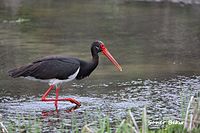Ciconia
| Ciconia Temporal range: Early Miocene to present
| |
|---|---|

| |
| Fledgling (left) and adult European white stork (Ciconia ciconia ciconia) | |
| Scientific classification | |
| Domain: | Eukaryota |
| Kingdom: | Animalia |
| Phylum: | Chordata |
| Class: | Aves |
| Order: | Ciconiiformes |
| Family: | Ciconiidae |
| Genus: | Ciconia Brisson, 1760 |
| Type species | |
| Ardea ciconia Linnaeus, 1758
| |
| Species | |
|
| |
| Synonyms | |
|
Dissoura Euxenura Sphenorhynchus | |
Ciconia (
The genus was introduced by the French zoologist Mathurin Jacques Brisson in 1760 with the white stork (Ciconia ciconia) as the type species.[1][2] The genus name is the Latin word for "stork",[3] and was originally recorded in the works of Horace and Ovid.[4]
The Abdim's stork is the smallest of the family, but other species in the genus are generally medium-sized storks, with long legs and a long thick bill. The members of this genus are more variable in plumage than other stork genera, but all species are black (at least to the wings) and white (at least underparts or neck). Juveniles are a duller, browner version of the adult.
Depending on species, breeding can be in solitary pairs or colonies. Pairs usually stay together for life. They typically build large stick nests in trees, although the Abdim's stork sometimes will nest on cliffs, the maguari stork will nest on the ground and at least three species will construct their nests on human habitations. One of these, the white stork, is probably the best known of all storks, with a wealth of legend and folklore associated with this familiar summer visitor to Europe.
These storks feed on frogs, insects, fish, crustaceans, small birds, lizards and rodents. They fly with the neck outstretched, like most other storks, but unlike herons which retract their neck in flight.
The migratory species like the white stork and the
Species
Extant species
The genus contains eight extant species:[5]
| Image | Scientific name | Common Name | Distribution |
|---|---|---|---|
| Ciconia abdimii | Abdim's stork | Widespread in open habitats of Sub-Saharan Africa, and in Yemen. Breeds in northern half of range and spends non-breeding period in southern half | |
 |
Ciconia episcopus | Asian woolly-necked stork | Southern Asia, from Pakistan to Indonesia and the Philippines |

|
Ciconia stormi | Storm's stork | Thai-Malay Peninsula
|

|
Ciconia nigra | Black stork | Breeds from Eastern Asia (Siberia and northern China) west to Central and Southern Europe. Winters in South, Southeast and East Asia, and in tropical Africa. A resident (non-migratory) population in southern Africa |
| Ciconia maguari | Maguari stork | Widespread in open wetland habitats in northern, central and southern South America | |
| Ciconia microscelis | African woolly-necked stork | tropical Africa | |
 |
Ciconia ciconia | White stork | Breeds in Europe to central Asia, and in northern Africa. Winters in Sub-Saharan Africa and South Asia |
| Ciconia boyciana | Oriental stork | Breeds in Russian Far East and northeast China. Winters in Japan, Korean Peninsula, east-central and southeast China, and Taiwan |
Fossils
The
Fossil members of the genus include:
- Ciconia louisebolesae (Early Miocene of Riversleigh, Australia)
- ?Ciconia minor (Early Miocene of Rusinga Island, Kenya)
- ?Ciconia sarmatica (Late Miocene of Credinţa, Romania)
- ?Ciconia gaudryi (Late Miocene/Early Pliocene of Pikermi, Greece)
- Ciconia sp. 1 (Late Miocene/Early Pliocene of Lee Creek Mine, the United States)
- Ciconia sp. 2 (Late Miocene/Early Pliocene of Lee Creek Mine, the United States)
- ?Ciconia kahli (Early Pliocene of South Africa)
- Ciconia lucida (Mongolian stork), (Middle Pliocene of Mongolia)
- Ciconia maltha (asphalt stork or La Brea stork), (Late Pliocene – Late Pleistocene of the western and southern United States, Cuba and Bolivia)
- Ciconia stehlini (Late Pliocene – Early Pleistocene of Hungary) – may belong to extant species
- Ciconia nana (Australian stork) – (Early to Middle Pliocene, Late Pleistocene of Australia) – formerly Xenorhynchus[6]
- Ciconia sp. (Late Pleistocene/Early Holocene of Las Breas de San Felipe, Cuba)[7]
A
References
- ^ Brisson, Mathurin Jacques (1760). Ornithologie, ou, Méthode Contenant la Division des Oiseaux en Ordres, Sections, Genres, Especes & leurs Variétés (in French and Latin). Paris: Jean-Baptiste Bauche. Vol. 1, p. 48, Vol. 5, p. 361.
- ^ Mayr, Ernst; Cottrell, G. William, eds. (1979). Check-list of Birds of the World. Vol. 1 (2nd ed.). Cambridge, Massachusetts: Museum of Comparative Zoology. p. 247.
- ISBN 0-19-910205-8.
- ISBN 0-304-52257-0.
- ^ Gill, Frank; Donsker, David, eds. (2019). "Storks, ibis, herons". World Bird List Version 9.1. International Ornithologists' Union. Retrieved 2 April 2019.
- ^ "Boles. W 2005 A Review of the Australian Fossil Storks of the Genus Ciconia (Aves: Ciconiidae), With the Description of a New Species" (PDF). Archived from the original (PDF) on 2011-07-06. Retrieved 2010-05-21.
- S2CID 86512215.
- JSTOR 1369460.
Further reading
- Barlow, Clive (1997): A field guide to birds of the Gambia and Senegal. ISBN 1-873403-32-1
- Cowles, Graham S. (1994): A new genus, three new species and two new records of extinct Holocene birds from Réunion Island, Indian Ocean. Geobios 27(1): 87–93.
- Grimmett, Richard; Inskipp, Carol, Inskipp, Tim & Byers, Clive (1999): Birds of India, Pakistan, Nepal, Bangladesh, Bhutan, Sri Lanka, and the Maldives. Princeton University Press, Princeton, N.J.. ISBN 0-691-04910-6
- Hilty, Steven L. (2003): Birds of Venezuela. ISBN 0-7136-6418-5
External links
- ARKive: images and movies of Ciconia boyciana
- Ciconia videos on Internet Bird Collection:
- Ecological education through live white storks' nest webcam observation Archived 2014-07-14 at the Wayback Machine
